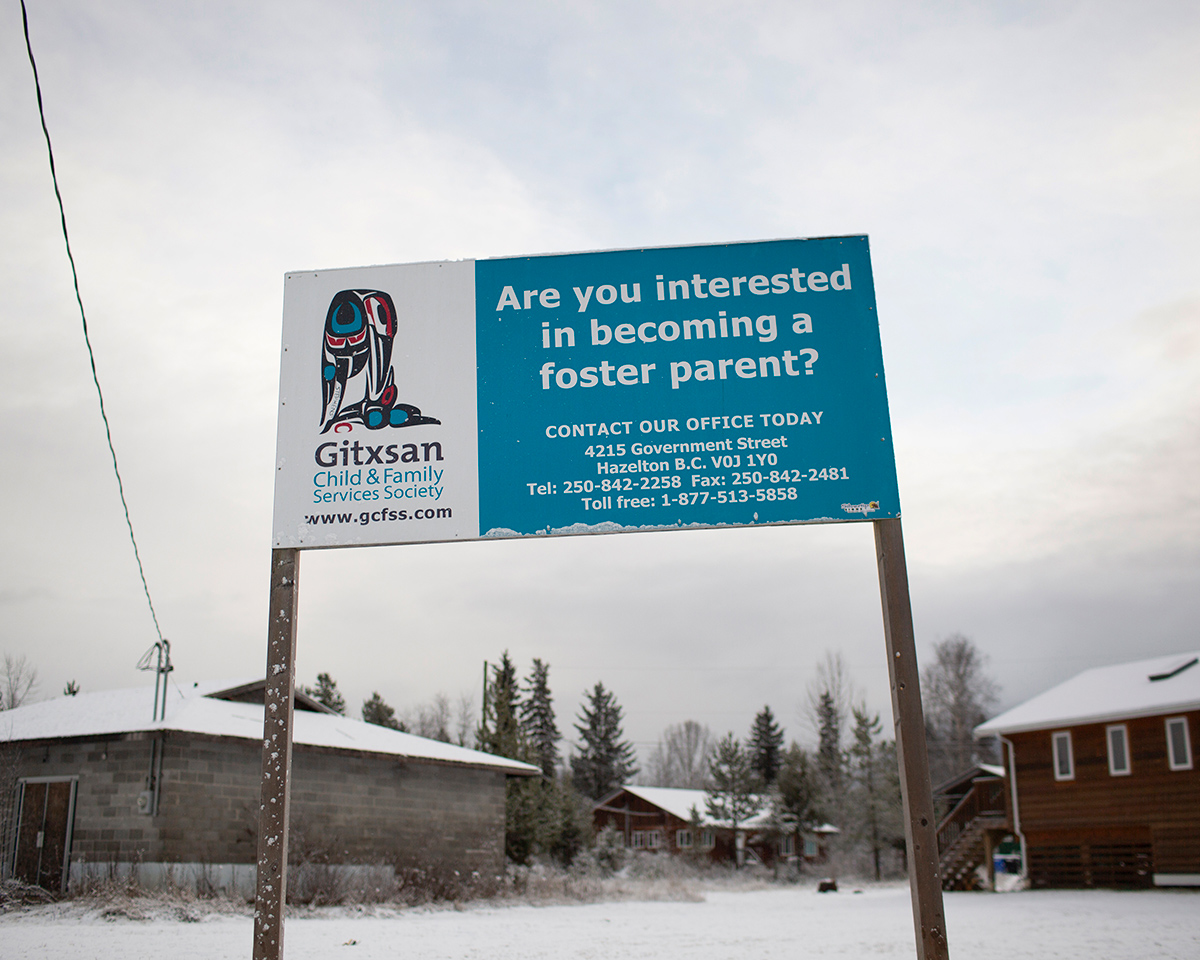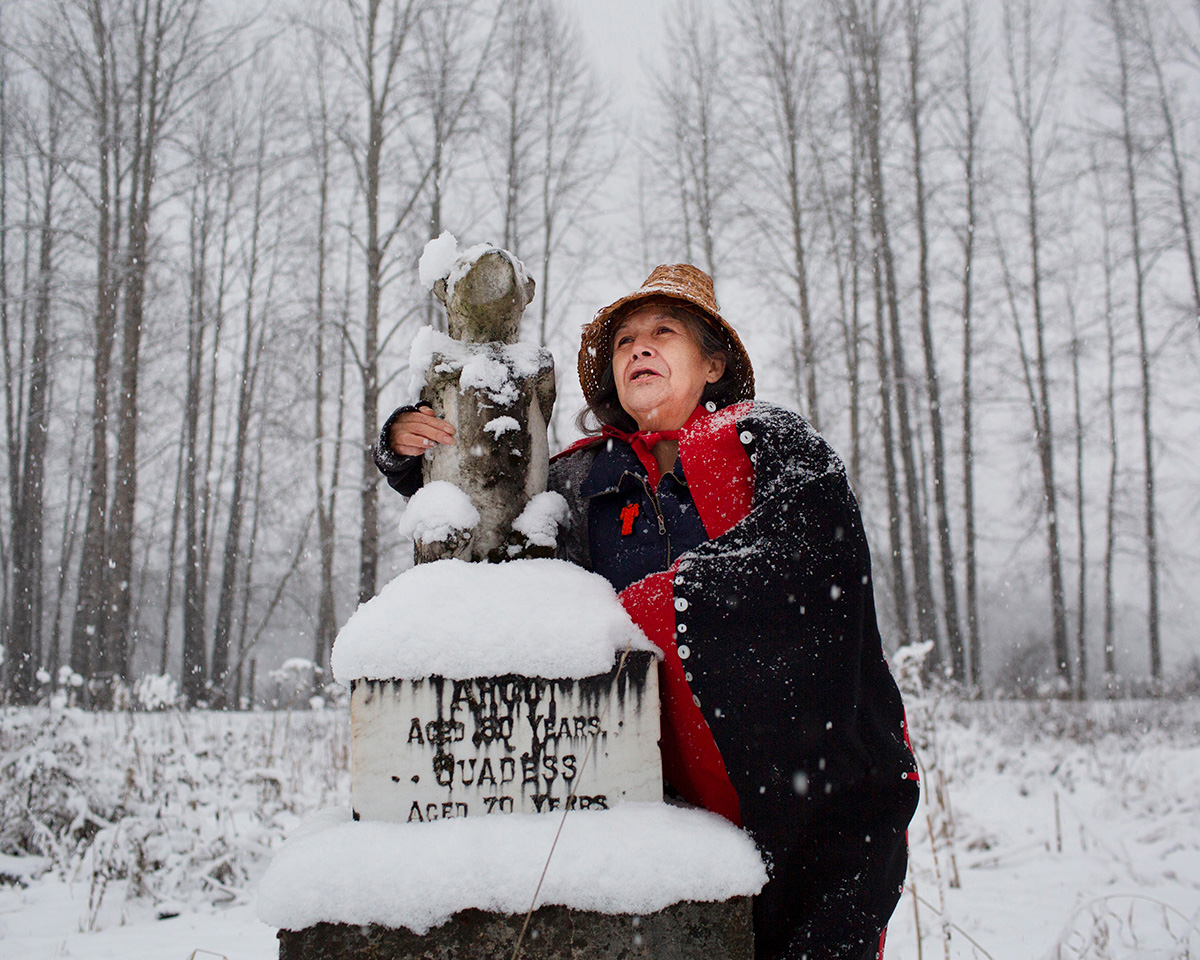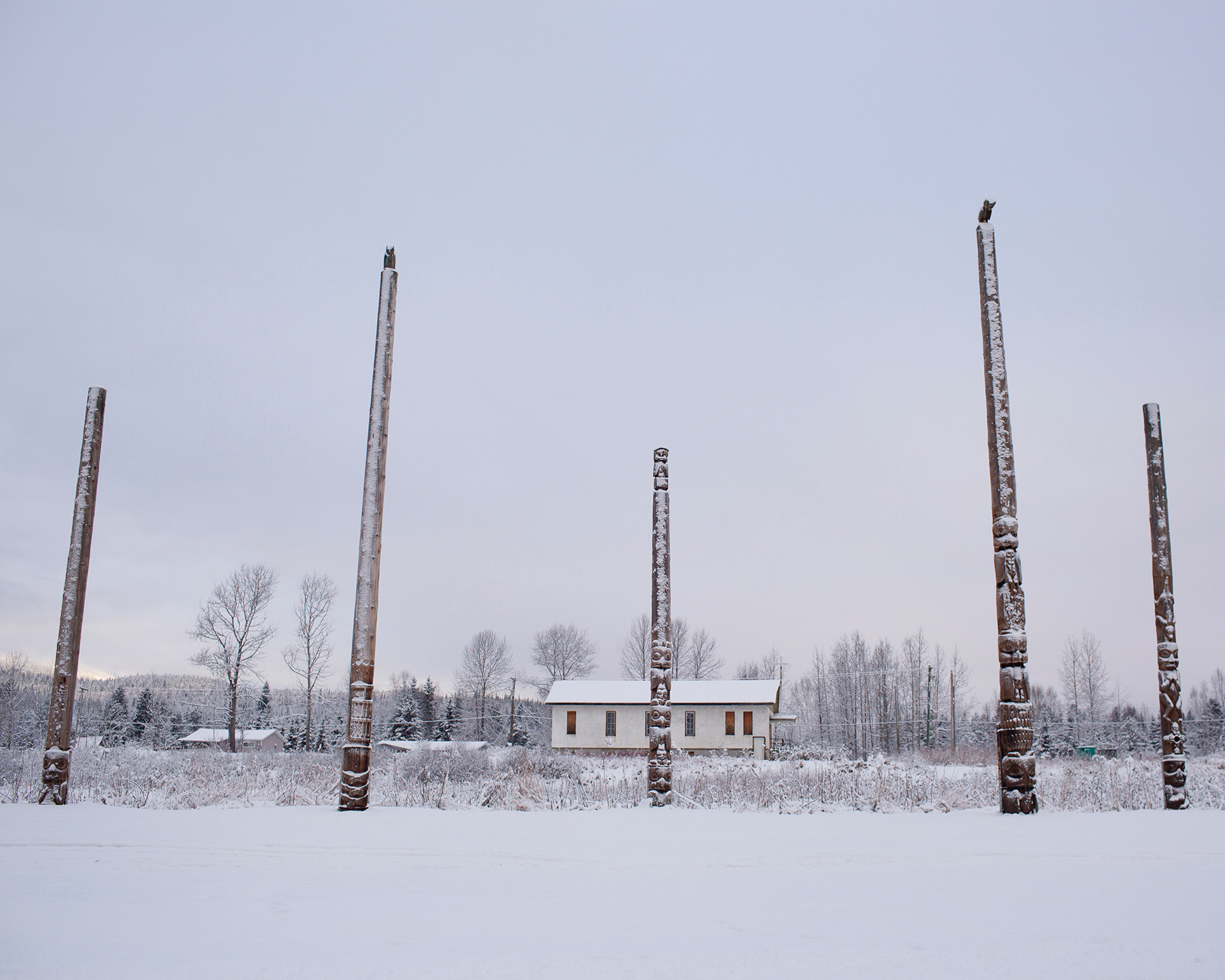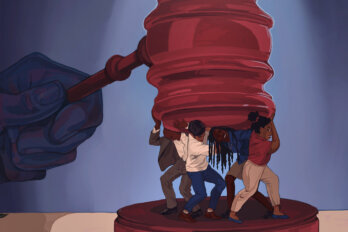On a cold evening in October 2021, a social worker from the British Columbia Ministry of Children and Family Development knocked on the door of a house in Gitanmaax, a community in the traditional territory of the Gitxsan First Nation in northern BC. Two social workers of the MCFD had come to apprehend a six-year-old Gitxsan girl. Mia (a pseudonym) had been on a week-long visit to her matrilineal family, including her mother and her aunt, and that night she was due to board a plane that would take her more than 4,000 kilometres east, back to her foster home in Ontario.
Mia’s aunt answered her door. She told the social workers she didn’t know where Mia was. Listening closely from the street were members of the Gitanmaax Band, to which Mia belongs, and her wilp, or house group, the Git’luuhl’um’hetxwit. These two Gitxsan groups represent two systems—elected and hereditary—that had come together to stand up for one of their children.
Mia was born in 2015 and was cared for by her mother, in Prince George, about five hours from Gitanmaax. When Mia was three years old, her father died. Her mother was struggling, so she entered into a voluntary care agreement with the MCFD, under which a child is temporarily placed in foster care. The MCFD placed Mia with a white foster family in Prince George.
During this time, the Gitanmaax Band and the wilp made numerous attempts to regain custody of her, none of which were successful. In 2021, the MCFD decided to find another family for Mia. Instead of contacting her matrilineal family, the MCFD placed her with non-Gitxsan relatives on her patrilineal side who were living in Ontario. This family agreed to assume Mia’s foster care. Devastated by the separation, Mia’s mother, their wilp, and the Gitanmaax Band made a request for Mia to visit. (The Walrus was unable to access the court documents surrounding Mia’s case, so the information was corroborated via members of her family and other involved parties.)
When Mia arrived for her visit in Gitanmaax, her arm was in a sling. She had a broken collarbone. According to members of the wilp, the social worker responsible for delivering Mia from Ontario told them her injury was the result of her falling off a bed. “The fact of the matter is that she rolled out of bed in the nighttime,” one member of the family in Ontario says. “That’s what happened to her collarbone.” Out of concern, the Gitanmaax Band requested the MCFD carry out an investigation and insisted that Mia remain on Gitxsan territories until the investigation was complete. According to Mia’s matrilineal family, the MCFD dismissed the possibility of an investigation, stating it had looked into the case and had no reason to be concerned. Mia was to return to Ontario as scheduled, the ministry informed them, and sent two social workers to collect her.
Outside Mia’s aunt’s house, the two social workers turned to face the group of family and community members. The interaction was live-streamed on social media. Tracey Woods, elected chief of the Gitanmaax Band Council, began to read from a prepared statement:
“The Truth and Reconciliation of Canada and Bill C-92 as identified by the government of Canada, has identified that the historical practice of removing children from their families resulted in the children suffering physical and mental abuse. It is with this in mind that the Gitanmaax Band Council takes the position that [Mia] will remain in the community of Gitanmaax located on the Gitxsan territories, until a time that the Gitanmaax Band Council are satisfied that the Ministry of Children and Family Development have made every effort to work with the Gitanmaax Band Council and the Gitanmaax Child Welfare Committee to take all of the steps to establish appropriate arrangements for the child to enable her to remain on the Gitxsan territories.”
The statement ended with Woods saying that the MCFD was not authorized to enter the Gitanmaax Reserve—where they were currently standing—for the purposes of removing Mia from her lax’yip, her traditional territories.
The social workers offered a polite, if slightly awkward, “thank you” and then walked back to their vehicle, where it appeared they were discussing what to do next. The group quietened. “It’s not so much a protest as it is an assertion of rights,” one person said in the live stream. That word, “protest,” is significant for many Gitxsan, who are often labelled as protesters by media when they try to assert their rights, like when several members of the nation were arrested for blockading a railway line to show their objection to the Coastal GasLink pipeline project in northern BC.
The social workers announced that the MCFD would stand down for the weekend but moved to take Mia’s suitcases to their vehicle. Before they could, according to those present that night, one family member informed the MCFD that both Mia and her belongings were going to stay. Her suitcases were returned to her family.
For members of the Git’luuhl’um’hexwit, Mia’s situation stands for something much bigger than what she may understand for a long time. It stands for the many generations that were taken before her and for the children still being taken—for a future where the majagalee, the flowers of the family, the children, can be cherished at home.

The Gitxsan people have their own long-standing system of taking care of the nation’s children. The society is matrilineal, so children are born into their mother’s wilp and are members for life. There may be several lineages in one wilp, and specific connections aren’t always remembered, particularly in larger families. Gitxsan citizenship and membership to a wilp can also be acquired through a process of adoption called ts’imilguudit, typically enacted when a Gitxsan person and non-Gitxsan person are married, or through siisihlguxhlxwst, when a child is raised by someone in her family other than her mother. But this form of adoption is a far cry from the separation of Indigenous children from their communities that often takes place through the provincial and federal foster care systems.
According to author Neil J. Sterritt in his book Mapping My Way Home: A Gitxsan History, Earl Muldon, an artist who assumed the hereditary chief’s title Delgamuukw, once said, “To us, adoption is the white man’s way of taking someone away from us. We had welfare people and church people pull our children away, but we take people in. And when we take someone in, it is usually a family member . . . Ts’imilguut is our word for bringing people in.” Muldon was also the lead plaintiff in the precedent-setting 1997 Supreme Court decision ruling that Aboriginal title exists in BC—and that Aboriginal title constituted a right to the land itself.
That right to the land is fundamental to the way many Gitxan define their relationships to one another and how families are raised. There are more than fifty wilps in Gitxsan society. Each wilp has its own lax’yip (land) according to ancient ayook (law) as well as its own adaawk (history) and aiyuukxws (crest). It is the wilp that defines who you are and which lax’yip you have rights to as a Gitxsan citizen. As a member of your mother’s wilp, you are allowed to hunt, fish, and gather mushrooms and plants on your wilp’s lax’yip.
When left to itself, the wilp acts as its own child protection system, ensuring that every member is responsible for the wilp, just as the wilp is responsible to every member. If the biological parents are unable to care for a child, the wilp will collectively decide which relative will take on the responsibility. “The child is in the centre of the circle because they are someone who is very important. They are the future,” says Raymond Harris, wing chief of the Git’luuhl’um’hexwit. “On the outer circle is the grandmother and grandfather, who will teach the customs and the traditions of the Gitxsan people.” This system predates contact with Europeans and is how many Gitxsan were raised, often by grandparents or aunts and uncles. Gitxsan society and the child protection system of the wilp have never been recognized by Canada’s federal child welfare system.
In 1951, an amendment to the Indian Act—the act of Parliament that has set the relationship between Indigenous people and the government of Canada since 1876—turned many social services, including child protection, from a federal to a provincial responsibility. The child welfare system did not require social workers to have training in First Nations, Métis, or Inuit cultures and wasn’t established to take into consideration what constitutes “child protection” outside of Euro-Canadian values. According to a 1992 Report of the Aboriginal Committee, between 1951 and 1964, “children of Aboriginal ancestry” went from representing 1 percent of all children in care across the country to more than one-third. In 2021, former Nunavut MP Mumilaaq Qaqqaq, in response to the revelation of unmarked grave sites found on the grounds of the former Kamloops Residential School in BC, stated: “Children are still being separated from their communities. Foster care is the new residential school system.”
According to the 2019 First Nations/Canadian Incidence Study of Reported Child Abuse and Neglect, a First Nations child is 17.2 times more likely to be placed in foster care than a non-Indigenous child. Cindy Blackstock, a Gitxsan citizen and executive director of the national nonprofit First Nations Child & Family Caring Society, says this is the “absolute manifestation of the multigenerational trauma” that is the result of the residential school system. “What we have is First Nations parents who are traumatized, and may have addictions issues to dull the pain of that trauma, giving birth to children who are naturally more vulnerable through conditions such as fetal alcohol spectrum disorder,” she says.
In BC, specifically, Indigenous children, most of whom are First Nations, represent over two-thirds of children in foster care despite making up only 10 percent of youth. The application of BC’s child welfare laws often leads to the conclusion that the best thing for a child is to be removed from their birth family. Once removed, it is doubtful if the children will ever be returned to their families, who have less access to social services and are more likely to live in poverty compared to people who are not First Nations. Several reports—including the Joint National Policy Review in 2000, the Wen:de report in 2005, and the auditor general of Canada reports in 2008 and 2011—recommend remedying these problems to give Indigenous families a chance to recover from the effects of trauma, but neither federal nor provincial governments have implemented these recommendations.
Mia’s voluntary care agreement was only ever meant to be temporary. According to the MCFD, which declined to comment on Mia’s case specifically, when a voluntary care agreement is in place, it is the ministry’s job to reunify children with their families as soon as possible, unless it is not in the child’s best interest. But according to a source with intimate knowledge of Mia’s case, notes taken by social workers show that Mia’s mother was loving and attentive; she only struggled because she was alone with three children and lacked the financial means to support her family. When determining a child’s best interest, the MCFD follows what is referred to as principles of “prevention” and “preservation,” under which it can provide financial support to families that are willing and able, as Mia’s mother was, to care for their children. It is part of the ministry’s broader mandate to “support families involved with the child welfare system by focusing on family preservation and keeping children and youth connected to their communities and culture . . . ” It is unclear why the ministry didn’t choose this route in Mia’s case. Instead, the MCFD worked with “family finders,” whose role is to assist the MCFD in tracing living relatives on both familial branches. But, according to the source, the “family finders” appear to have traced her lineage only on her father’s side and not on her mother’s.
Under the British Columbia Child, Family and Community Service Act (CFCSA) and Bill C-92—a federal act concerning First Nations, Métis, and Inuit children, youth, and families—a permanent placement with a family cannot occur unless there is consent from the child’s parents and community. According to several sources in the community, when Mia’s mother and the band were notified of the MCFD’s intent to permanently place Mia with her cousins in Ontario, they refused to give consent, citing the CFCSA and Bill C-92.
By January 2021, there were two applications before BC provincial court judge Susan Mengering. The first was the patrilineal cousins’ Family Law Act (FLA) application for Mia’s guardianship. The second was the MCFD’s CFCSA application for a three-month temporary custody order naming the patrilineal cousins. If either of those applications was approved, Mia would go to Ontario under temporary custody, which would be extended until permanent custody is granted, leaving Mia completely removed from her mother, language, and culture by an order of the state. The family in Ontario self-identifies as Métis and is part of the Eastern Woodland Métis of Nova Scotia, a status that has not been recognized by a court for Métis communities east of Ontario. Members of the Git’luuhl’um’hexwit believe the MCFD is using this self-declared status to convince the judge that, in staying with the Ontario family, Mia’s cultural identity as an “Indigenous” child would be fulfilled.
The MCFD rejected the Gitanmaax Band’s petition to keep Mia close to her mother on Gitxsan territory. Without an agreement, Mia’s mother and the Gitanmaax Band were left with two options: give up or go to trial. They chose the latter.
During a court hearing that October, the MCFD announced an unusual last-minute notification to the judge: it intended to send Mia to her cousins in Ontario until the end of the trial, for an “extended stay.” This worried members of the Git’luuhl’um’hexwit, because it is commonly understood in family law that judges are far more reluctant to move children once they have established themselves within a family. Because the MCFD was Mia’s legal guardian, the judge could not deny the request, and Mia was sent to Ontario.
Knowing they needed to move quickly, the Gitanmaax Band filed a request for Mia to visit her mother and community and named Mia’s aunt as the caregiver. It was two weeks later that Mia arrived with her broken collarbone.

It’s true that Mia’s aunt didn’t know exactly where her niece was the evening the MCFD social workers arrived. Mia was with Rosaline Starr Gawa 2Auntys, a wilp matriarch, at an undisclosed location.
Earlier that day, Rosaline, along with other members of the community, visited Mia’s aunt’s house. They told her they were taking Mia for a day of lunch and shopping. Mia’s aunt reminded them that the MCFD would be arriving at seven in the evening to pick Mia up for her flight back to Ontario. “The tricky part,” says Kolin Sutherland Wilson, a member of the Git’luuhl’um’hetxwit wilp, “is that we couldn’t tell her we were taking [Mia] to a safe house because of the position she was in.” Mia’s aunt had signed up to be the girl’s legal caregiver for the duration of the visit. Involving her in concealing Mia would place her at risk of scrutiny from the MCFD, who would likely question her capability as Mia’s caregiver, potentially ruining any chance of her caring for Mia in the future.
By evening, Rosaline and Mia had settled in the safe house. Rosaline watched the live stream as the social workers arrived and community members gathered outside Mia’s aunt’s house. “I could see them and I was blown away,” Rosaline says. “I was so happy to see how many people were supporting besides my wilp members.” The following day, Wilson posted on social media: “[Mia] is safe and surrounded by loved ones and Git’luuhl’um’hetxwit Matriarchs. She is learning our language, playing with cousins, and hearing the stories of her ancestors.”
After the social workers stood down, the tension subsided through the weekend. Come Monday, Mia’s family says, the MCFD agreed for Mia to remain on Gitxsan territory on the condition that she continue to be cared for by her aunt. The women, fearful of another attempt at apprehension, remained at the safe house with Mia for the next six days.
On day three, the group hoped it would be safe enough to take Mia to a doctor to have her collarbone checked. After dusk, with Wilson leading the way, carrying Mia in his arms, the group followed a trail in single file toward the hospital. They didn’t necessarily trust the MCFD’s word that they wouldn’t apprehend Mia, so Wilson, as a wildigyet, a warrior of his wilp, waited outside the hospital while Mia went in, watching for signs of authorities. “At that point, I basically felt like I’m fully willing to be arrested for obstructing RCMP officers and MCFD agents,” Wilson says. “There is literally nothing more important to me than our kids, and I’ll one hundred percent stand in between.” Mia’s collarbone was healing well. Before long, they were back in the safe house, hoping they hadn’t been seen.
Six days after Mia arrived, the wilp received news that an agreement had been made between the MCFD and Gitanmaax Band. Mia would stay in Gitanmaax with her aunt until the case returned to court for another hearing. There would be no attempt by any authorities to apprehend her before then, the MCFD told them, because it would only add to Mia’s trauma. She would be free to live in Gitanmaax, where she would be enrolled, alongside her siblings and cousins, at the local school.
At the local elementary school, Mia began learning Gitxsanimx, the Gitxsan language. “Because for the Gitxsan, for this child, it’s so important,” says wing chief Harris. “So we have to make them belong.” The word “belong” comes up often in conversations with members of the wilp. “Going back to your land is where you can feel like you belong,” Rosaline explains. “Not feeling like you are missing your culture, not feeling like you don’t belong.” The wilp members have all, in one way or another, been denied, again and again, their sense of belonging—of growing up surrounded by their family, by their culture, by their language. For many, belonging is either a memory, an aspiration, or both.
Several members of Mia’s wilp—many of whom are residential school survivors or descendants of residential school survivors—see the current child welfare system as simply a continuation of the residential school system and the Sixties Scoop, the mass removal of Indigenous children from their homes and their placement in the child welfare system and residential schools. “That’s why colonization is still going on,” Harris says, “and [Mia] is an example.”
When Harris was a boy growing up in Gitanmaax in the 1960s, Department of Indian Affairs agents took him 1,000 kilometres away, to Alberta, where he attended the Edmonton Indian Residential School for ten years. He had blamed his mother for sending him to this unknown place “until I figured it out,” he says. In 1920, the Indian Act had been amended to combat low attendance at residential schools, making it mandatory for “Indian” children to attend. If a parent or guardian refused to hand over their child, the Indian Act gave powers to a government agent to enter a home, seize the child, and arrest, fine, and imprison the parent or guardian. “It wasn’t her that sent me,” says Harris. He remembers the day he left Gitanmaax, and the camaraderie of the train ride with the other boys. “It was exciting, all the kids were excited,” he says. “We got to the station in Edmonton and [got dropped off] at the residential school, and that’s when everything changed. There was no more camaraderie.”
While the goal of residential schools was to assimilate Indigenous children into Canadian society, the overarching purpose of the country’s current child welfare systems is to protect children. But contemporary notions of child protection have been shown to be rooted in many of the same philosophies that motivated the removal of Indigenous children during the residential school era. In a 1967 study prepared for the Department of Indian Affairs and Northern Development, project director George Caldwell found that 80 percent of children placed in residential schools in Saskatchewan were there because of the “welfare of the family.”
The percentage is echoed in a March 2021 report released by the MCFD that says that 84 percent of Indigenous children in foster care were there due to “neglect.” But neglect from whom, exactly? The Canadian Incidence Study of Reported Child Abuse and Neglect shows that the driving factors behind children being apprehended from First Nations parents due to “neglect” are poverty, poor housing, caregiver substance misuse, caregiver mental health, and domestic violence. The problem, says Blackstock, is that child welfare laws codify structural discrimination as a parental deficit; in other words, the buck stops with the parents. “You won’t find a provincial statute that asks the question: What is the actual source of this risk?” For example, if the government underfunded every service in Toronto for five years, the parenting abilities of everyone in the city with children would decline. “The problem isn’t their parenting,” Blackstock says, “it’s the fact that they’re getting less than everybody else.”
After the last state-run residential school in Canada closed, in 1996, there has been a distinct lack of services dealing with mental health and addiction issues that flowed from being a victim of that system. The government, Blackstock says, foisted a narrative onto Indigenous people that “you’re the ones that need to heal.” She doesn’t like the term “healing,” she says, concerning the legacy of the residential school system, because it recasts the structural and systemic discrimination as a personal deficit. “It’s not about healing, it’s about the individual being put in a circumstance where they can have success.”
To help avoid situations like Mia’s, an obvious solution would be for governments to invest in a broad set of services, but that requires more than handouts. Structural inequalities such as poverty, housing, and access to services—programming, infrastructure, funding for health care and education—will all need to be addressed for society to see healthier families and a reduced number of children in care, says Blackstock. In 2000, the Assembly of First Nations released a National Policy Review on First Nations Child and Family Services, calculating it would cost hundreds of millions of dollars to reform the child welfare system and fix the overrepresentation of First Nations children. The federal government decided against its recommendations.
Last year, a court ordered the federal government to pay $20 billion to reform the child welfare system and $20 billion in compensation to victims, who, according to Blackstock, wouldn’t have been victimized had the government taken action following the National Policy Review. This payout follows another landmark court ruling that dismissed an application by the attorney general for a judicial review of compensation orders for First Nations children affected by the child welfare system.
This delay of more than two decades has had significant consequences for First Nations children. “Today, we can see stark differences in child functioning between First Nations kids and non-Indigenous kids,” says Blackstock—in part because of systemic discrimination and lack of services that can lead to the higher rates of developmental delay and fetal alcohol syndrome. “All that trauma has gotten deeper, and it’s going to cost more to get out of.”
In the year after Mia returned to Gitanmaax, she continues to be cared for by her aunt, and her mother has been enjoying frequent visits to see her daughter. It will stay this way until a final resolution is reached, which, for Mia’s mother and the Gitanmaax Band, requires the MCFD to withdraw its applications before the judge for custody. (The family in Ontario has already withdrawn its request.)
When Mia first arrived in Gitanmaax to visit the wilp, before the MCFD social workers came to collect her, the community hosted a welcome ceremony for her. She was gifted a vest with her ancient family crest, and after walking alongside her siblings and cousins to the centre of a circle of relatives, she was formally introduced to each member of her family. Among the circle was Mia’s great-uncle, who shared that, when he was a boy, walking home from school one day, an agent pulled up alongside him in a Department of Indian Affairs car. The agent told him that his grandmother was ill and that he should jump in the car so that the agent could take him to her. He got in. He didn’t see his family for the next fifty years.
The wilp had no way of knowing what had happened to him. (It wasn’t until 1980 that the CFCSA required social workers to notify the band council upon the removal of a child.) But members had suspected that he had been taken by Department of Indian Affairs agents. He remembers the agents telling him that his family and community didn’t want to see him again, and as a young boy, he had no reason not to believe them. In 2009, he plucked up the courage to return to Gitanmaax, but it was during Mia’s welcome ceremony that he opened up more fully about what had happened to him when he disappeared from the community.
As Mia was welcomed home by the hereditary house chiefs, they explained that, through her matrilineage, the land on which she stood was her inheritance. The land belonged to her and all the future generations of majagalee—the flowers of the family, the children—on which to flourish and thrive.





